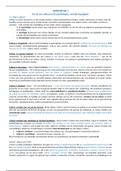Class notes
College aantekeningen Migrants and integration ()
- Course
- Institution
These lecture notes on Migration and Integration provide an overview of migration policy, theoretical explanations of migration flows, and the dynamics of socio-economic and cultural integration as they are explained within the lectures.All lecture material is covered and include key theories like ...
[Show more]






